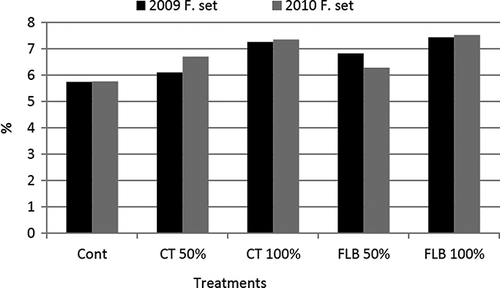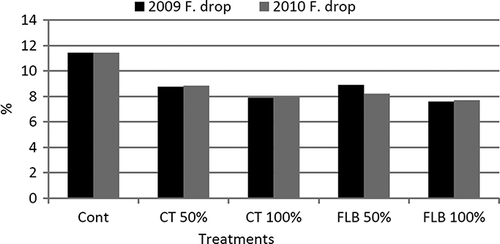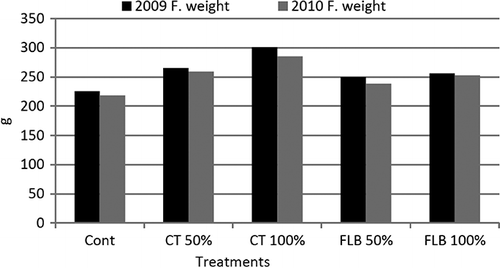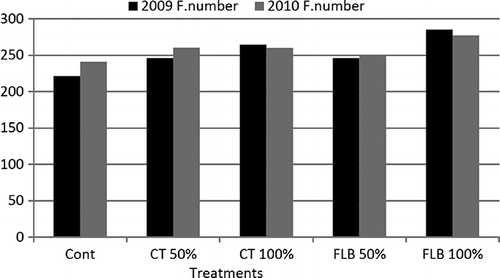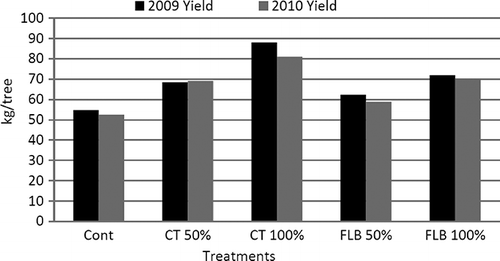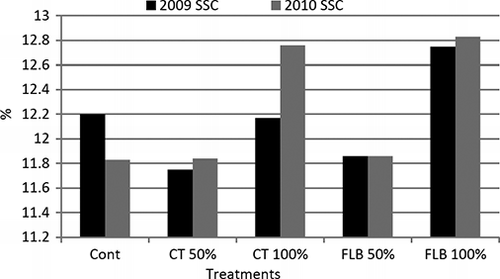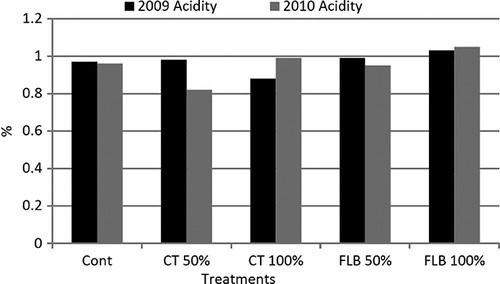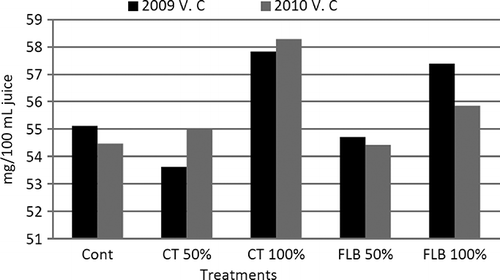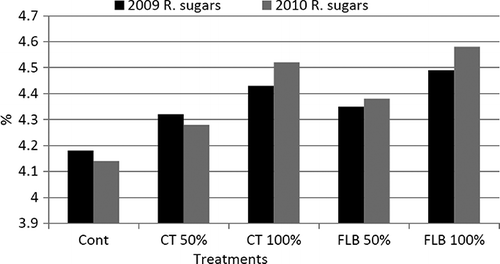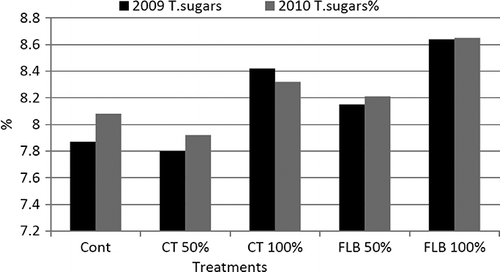Abstract
Sixteen-year-old navel orange trees at a private orchard located in Kafer El-Sheikh Governorate, Egypt, were used in this study. Compost tea (CT) and filtrate biogas slurry liquid (FLB) were applied at two different concentrations (50% and 100%); control trees were sprayed with water. Trees treated with CT at 100% were the highest in yield, fruit weight, and vitamin C, whereas the highest percentage of fruit set, fruit number, and soluble solid content (SSC), lowest fruit drop, and highest reducing and total sugars were in trees treated with 100% FLB. Concentrations at 50% for both foliar application (CT and FLB) improved yield and fruit characteristics than control treatment. Generally, using a foliar application of compost tea and filtrate biogas slurry liquid at (100%) treatments as food nutrients could be recommended to improve the yield and fruit quality of navel orange fruits under the current study conditions.
Consequently from the previously mentioned results, it was clear the great role of compost tea (CT) and filtrate biogas slurry liquid (FLB) as two sources of foliar application of organic fertilization for Washington navel orange grown in a clay loamy soil, as they are indispensable for improvement of the nutritional status of the navel orange trees and production of maximum yield and quality of orange, as well as minimizing the cost of production and in turn increasing the income of orange orchard. So, it should be recommended the superiority of application of FLB and CT, especially 100%, which gave the best results in yield and physical and chemical characteristics of navel orange fruits.
Introduction
Egyptian climate is well suited for orange production, which accounts for over half of the total fruit production in Egypt (Agriculture Statistics of Egypt, 2010). Total Egyptian orange exports achieved 653,000 Mt (CitationSpreen, 2010). Navel orange is considered the main orange variety in Egypt during winter.
The problems associated with the use of hazardous chemicals for crop protection and weed control have received increasing attention worldwide, since pests, diseases, and weeds become resistant to chemical pesticides and environmental pollution. Organic fertilizers are increasingly playing a more important role as substitutes to chemical fertilizers, where most organic fertilizers are made out of many kinds of agricultural wastes such as animal dung and plant residues (CitationLarptansuphaphal and Jitumroochokchai, 2009). However, there are reports showing that using organic fertilizers increased the development of some diseases (CitationChauhan et al., 2000). In many studies, application of compost extracts (compost tea), which are filtrated solution of compost materials and water mixtures, showed promising results on crop protection after a soaking period referred to as “extraction time” (CitationGhorbani et al., 2006). The concept behind compost tea is quite simple, though the actual process of making compost tea becomes scientific and very complex. The idea is that compost (full of beneficial microorganisms) is mixed with water and then supplemented with nutrients for the growth of microorganisms. This procedure reduces the pollution caused by nutrients through reducing the amounts of fertilizers added to soil (CitationAbou El-nour, 2002). The effects of compost application either as extracts to the foliage or as soil amendments on plant disease control may be due to direct antifungal or resistance-inducing/plant-strengthening effects. However, the mechanism by which compost extracts work is not well known but seems to vary depending on the host-pathogen relationship and the mode of application (CitationGoldstein, 2002). Moreover, several studies revealed that foliar application is more efficient than soil fertilization, under arid and semiarid conditions (CitationAmberger, 1991; CitationEl-Fouly and El-Sayed, 1997; CitationEl-Fouly and Rezk, 1986). Also, organic fertilizers such as liquid pig manure, matured cattle manure, and sugarcane husks applied directly to the soil showed promising results in control of some crop diseases (CitationDeCeuster and Hoitink, 1999; CitationViana et al., 2000). Liquid biogas is prepared similarly to the herbal tea in which the material is fully immersed in barrel during the fermenting period, then strained and diluted and used as a foliar spray or soil drench.
The goal of this research is to study beneficial effects of compost tea (CT) and filtrate biogas slurry liquid (FLB) on yield and fruit quality of navel orange fruits.
Materials and Methods
This study was carried out during 2009 and 2010 seasons on Washington navel orange (Citrus sinensis Osbeck) trees grown at Kafr El-Sheikh Governorate, Egypt. The selected trees were 16 years old, budded on sour orange rootstock, and planted at 5 × 5 m apart in a clay loamy soil with water table of 1.5 m. The selected trees were uniform in both vegetative growth and fruit-bearing load. The experiment in each season included five treatments applied on May 15 and July 15, as follows:
1—Control (sprayed with water on the two days of treatments). | |||||
2—Compost tea (CT) 50%. | |||||
3—Compost tea (CT) 100%. | |||||
4—Filtrate biogas slurry liquid (FLB) 50%. | |||||
5—Filtrate biogas slurry liquid (FLB) 100%. | |||||
Preparation of aerobic compost tea and filtrate biogas slurry
Compost tea
Rice straw compost was made from rice straw Sakha 101 residues, cattle dung manure at Agricultural Botany Department, Faculty of Agriculture, Kafrelsheikh University, Egypt. Rice straw was shred. Then all other materials were mixed and arranged in heaps at 2 m width × 1.5 m height × 5 m length, which were regularly turned and moistened with water (55–65%) for 70 days to ensure appropriate composting conditions (turned windrow system). The heaps were covered with plastic to reduce the moisture evaporation from the surface of the piles, consequently preventing the dynamics of the piles. Heaps were moistened when needed and weekly turned to ensure adequate aeration and high decomposition. The compost was inoculated with starter from mesophilic and thermophilic lignolytic and cellulolytic microorganisms to accelerate the degradation rate (3 × 107 colony-forming units [cfu]/g rice straw) (CitationBelal and El-Mahrouk, 2010). Maturity of compost was shown when the temperature inside the heap decreased and was similar to air temperature around the heap, also decreasing the carbon/nitrogen (C/N) ratio of compost at the end of composting comparing with the raw materials. C/N ratio of rice straw compost at the beginning of composting process was 30:1 and it was 15.2 at the end of composting period. Heaps were inoculated at maturity stage with Trichoderma harzianum and plant growth promoter rhizobacteria (PGBR) (4 × 108 cfu/g mature compost). Compost tea was prepared by brewing compost and water at a ratio of 1:5 w/v (compost:water) with continuous aeration. Tap water was added to the brewing tank approximately 24 hr prior to use to allow volatilization of chlorine (CitationNaidu et al., 2010). After that, compost tea was filtrated. The filtrated solution was diluted two times for foliar spraying. Physicochemical characteristics of compost tea are given in .
Table 1. Physicochemical characteristics of soils (clay and sandy), compost, and biogas slurry
Filtrate biogas slurry
Filtrate biogas slurry was prepared from biogas slurry after production of biogas from rice straw and cattle manure (CitationEltawil and Belal, 2009). Biogas slurry was diluted with tap water at a ratio 1:5 w/v (biogas slurry:water) and filtrated. The filtrate was diluted two times using for foliar spraying. Physicochemical characteristics of biogas slurry are given in .
June drop and preharvest fruit drop: The percentage of fruit drop was calculated according to the following equation:
At harvest time (December 10), fruit samples of each replicate (three replicates, one tree per replicate) were picked separately for determining physical attributes (total yield of each tree [kg/tree] and fruit weight [g]) and chemical attributes (soluble solids content [SSC %], titratable acidity [%], and vitamin C [mg/100 mL juice]), as described by the CitationAssociation of Official Analytical Chemists (AOAC) (1990).
Statistical analysis
The differences between the treatment groups and the control group were analyzed in complete randomized model with three replicates, one tree per each replicate according to (CitationLittle and Hills, 1972), using SPSS Statistics 17.0 software (Statistical Packages for the Social Sciences, released 23 August 2008; SPSS Institute, Chicago, IL). Duncan's new multiple-range test was used to identify which treatment conditions were significantly different from each other (CitationDuncan, 1965). P ≤ 0.05 was set as limit of significance.
Results
Effect of foliar application on physical characteristics
Fruit set (%)
The results showed that all tested treatments significantly increased fruit set percentage in both seasons as compared with control. Treatment 5 (T5) (FLB 100%) achieved the highest fruit set percentage (7.43% and 7.52%) as compared with that of T1 (control) (5.74% and 5.76%) in 2009 and 2010 seasons, respectively ().
Fruit drop (%)
All the experimental treatments significantly decreased fruit drop percentage as compared with control. Maximum fruit drop percentage (11.44%) was observed from control trees, whereas minimum fruit drop (7.60 %) was achieved in FLB 100% treatment, in the first season ().
Fruit weight (g)
The weight of fruit was, however, significantly increased by all foliar treatments, of which the maximum weight of 300.88 g was attained with FLB 100% treatment. The CT and FLB foliar application with respect to weight was found to be statistically significant. Minimum weight (225.70 and 218.64 g) was observed from control trees in both seasons ().
Fruit number
The number of fruit per tree showed significant differences among treatments. Greatest number of fruit per tree (285.00) was achieved in fruits with FLB 100% treatment, which was statically different in foliar application either applied in 2009 or in 2010 season. The lowest number of fruit per tree (221.28 and 240.76) was observed in control treatment in both seasons, respectively ().
Yield (kg/tree)
Results showed that foliar application with CT and FLB (50% and 100%) significantly increased the fruit yield of navel oranges compared with the control treatment (). The maximum fruit yield of 88.03 kg/tree was obtained from the treatment receiving 100% CT, followed by 81.01 kg/tree from FLB 100% treatment. The yield differences among such treatments were statistically at par with each other, indicating foliar sprays of CT and FLB were effective in increasing the fruit yield over control.
Effect of foliar application on chemical characteristics
SSC (%)
CT and FLB application significantly affected SSC % in both seasons. However, the response of navel orange to different foliar applications was different (). Maximum SSC percentage (12.86%) was recorded in trees supplied with FLB 100%. Minimum SSC percentage (11.78%) was observed from CT 50% treatment in both seasons.
Acidity (%)
There was no evident significant effect caused by the CT, FLB, and control treatments in experiment during both seasons. CT 50% observed the lowest percentage of acidity content (0.82%) in the second season as compared with other treatments ().
Vitamin C
Vitamin C in fruits was significantly affected by different foliar applications. The greatest amount of vitamin C (58.29 mg/100 mL juice) was recorded in CT 100% application and lowest (55.85 mg/100 mL juice) in control in both seasons ().
Reducing sugars (%)
Results of reducing sugars were illustrated in . There was an increase in reducing sugars content of navel orange fruit through foliar applications irrespective of the concentrations of application compared with the control treatment. FLB 100% treatment gave a significant increase in the second seasons as compared with other treatments. Control fruit was the lowest reducing sugars percentage (4.18% and 4.14%) in both seasons, respectively.
Total sugars (%)
A significant variation was recorded in trees treated with CT, FLB, and control treatments. Analysis of variance showed that higher total sugars were taken by the trees receiving high and low concentrations of CT and FLB as compared with untreated trees in control treatment in both seasons ().
Discussion
Yield and physical characteristics
Several researchers revealed that foliar feeding is more efficient than soil fertilization (CitationHavlin et al., 2005; CitationOmaima and El-Metwally, 2007; CitationTariq et al., 2007). Data concerning the effect of CT and FLB as two sources of foliar application of organic fertilization on yield and physical characteristics of navel orange trees are illustrated in , , and . Data revealed that there were significant difference in the fruit set, fruit drop, and the yield per tree due to source of organic used. On the other hand, levels of concentration significantly affected the fruit set, fruit drop, and the yield per tree. It was also noticed through our study that the yield per tree was increased with increasing level of concentration up to 100%/tree as compared with control and the other level of concentration (50%). The increase in fruit yield was related to both large fruit weight and greater set of fruits. shows that higher levels of concentration gave not only increase in fruit yield but also higher fruit number and lower fruit drop percentages. This suggests that the yield influence with increase organic fertilizer concentrate is a response to source of organic fertilizer. Furthermore, number and weight of fruits and the yield per tree respond more positively to the different concentrate application in the first season than in the second season.
These results are in agreement with those reported by CitationMostafa et al., 2009, who reported that the yield and fruit quality significantly increased when applied compost tea, which as foliar application was used on Washington navel orange trees and on Thompson seedless grapevines (CitationAbd El-Maksood, 2006; CitationEl-Mansi, 2007; CitationEzz, 1999; CitationOmar, 2005). Also, CitationFayed (2010) revealed that increase level application increase fruit production on Manfalouty pomegranate trees.
Chemical properties
Data showed that organic source affected significantly the most chemical properties of the Washington navel orange. Meanwhile, foliar application of organic fertilization level (100%) caused an increase in the soluble solids content, vitamin C, and total sugars percentages, whereas percentage of acidity content was unaffected by organic source and concentration as compared with the control.
The obtained results are in agreement with the findings of CitationMansour and Shaaban (2007), who reported that organic source applications significantly improved chemical properties of fruits as compared with mineral sources on Washington navel orange. Also, CitationFayed (2010) found that compost tea as foliar application gave a significant increase in total sugars in fruits on Manfalouty pomegranate trees. Similarly, CitationAbd El-Hamied (2007), who found that combination between compost tea and chicken manure extract at rate 1:10 (compost:water) improved fruit quality on Thompson seedless grapevines.
Conclusion
Consequently from the previously mentioned results, it was clear the great role of compost tea (CT) and filtrate biogas slurry liquid (FLB) as two sources of foliar application of organic fertilization for Washington navel orange grown in a clay loamy soil, as they are indispensable for improvement of the nutritional status of the navel orange trees and production of maximum yield and quality of orange, as well as minimizing the cost of production and in turn increasing the income of orange orchard. So, it should be recommended the superiority of application of (FLB) and (CT), especially 100%, which gave the best results in yield and physical and chemical characteristics of navel orange fruits.
Acknowledgments
The authors thank the Deanship of Scientific Research and Research Center, College of Food and Agricultural Sciences, King Saud University, Kingdom of Saudi Arabia, for funding this research.
References
- Abd El-Hamied , S.Y. 2007 . Effect of some natural organic nutrients on Thompson seedless grapevines , Egypt : Ph.D. dissertation, Faculty of Agriculture, Mansoura University, Mansoura .
- Abd El-Maksood , B.E. 2006 . Effect of some kinds of fertilizers on yield and quality of Thompson seedless grapevines (Vitis vinifera, L.) , Mansoura, Egypt : Ph.D. dissertation, Faculty of Agriculture, Mansoura University .
- Abou El-nour , E.A.A. 2002 . Can supplemented potassium foliar feeding reduce the recommended soil potassium? . Pak. J. Biol. Sci. , 5 : 259 – 262 .
- Amberger , A.A. Importance of micronutrients for crop production under semi-arid conditions of North Africa and Middle East . Proceedings of the 4th Micronutrients Workshop . Amman , Jordan. pp. 5 – 30 . Cairo : NRC .
- Anonymous . 2010 . Agriculture Statistics of Egypt, 2009–2010 , 9 Cairo : Government of Egypt, Ministry of Agriculture and Land Reclamation . Division (Economic Wing)
- Association of Official Analytical Chemists . 1990 . Official Methods of Analysis , 15th , Washington , DC : Association of Official Analytical Chemists .
- Belal , E.B. and El-Mahrouk , M.E. 2010 . Solid-state fermentation of rice straw residues for its use as growing medium in ornamental nurseries . Acta Astronaut. , 67 : 1081 – 1089 .
- Chauhan , R.S. , Maheshwari , S.K. and Gandhi , S.K. 2000 . Effect of nitrogen, phosphorus and farm yard manure levels on stem rot of cauliflower caused by Rhizoctonia solani . Agric. Sci. Digest. , 20 : 36 – 38 .
- DeCeuster , T.J.J. and Hoitink , H.A.J. 1999 . Using compost to control plant diseases . BioCycle , 40 : 61 – 63 .
- Duncan , D.B. 1965 . Multiple range and multiple F-test . Biometrics , 11 : 1 – 42 .
- El-Fouly , M. M. and El-Sayed , A. A. 1997 . “ Foliar fertilization; an environmentally friendly application of fertilizers ” . In Proceedings of Dahlia Greidinger International Symposium on Fertilization and the Environment , Edited by: Mortvedt , J. J. 346 – 358 . Technian Haifa .
- EI-Fouly , M.M. and Rezk , A.I. 1986 . “ Micronutrients status of some food crops and increasing yields through micronutrient foliar application in Behira, Egypt ” . In Foliar Fertilization , Edited by: Alexander , A. 153 – 169 . Boston : Martinus Nijhoff Publ. .
- El-Mansi , A.A. 2007 . Evaluation of organic fertilization in Thompson seedless vineyards , Mansoura , , Egypt : M.Sc. thesis, Faculty of Agriculture, Mansoura University .
- Eltawil , M.A. and Belal , E.B.A. 2009 . Evaluation and scrubbing of biogas generation from agricultural wastes and water hyacinth . Misr. J. Agr. Eng. , 26 : 534 – 560 .
- Ezz , T.M. 1999 . Response of Thompson seedless grapevines grown in calcareous soil to organic fertilizer “Bio Treasure” and cattle manure application . J. Agric. Sci. Mansoura Univ. , 24 : 1987 – 1996 .
- Fayed , T.A. 2010 . Effect of compost tea and some antioxidants applications on leaf chemical constituents, yield and fruit quality of pomegranate . World J. Agric. Sci. , 6 : 402 – 411 .
- Ghorbani , A. , Koocheki , A. , Jahan , M. and Aasadi , G. 2006 . Effects of organic fertilizers and compost extracts on organic tomato production . Aspect. Appl. Biol. , 79 : 113 – 116 .
- Goldstein , J. 2002 . Compost suppresses disease in the lab and on the fields . BioCycle , 39 : 62 – 64 .
- Havlin , J.L. , Beaton , J.D. , Tisdale , S.L. and Nelson , W.L. 2005 . Soil Fertility and Fertilizers: An Introduction to Nutrient Management , 7th , Upper Saddle River , NJ : Pearson/Prentice Hall .
- Larptansuphaphal , T. and Jitumroochokchai , P. 2009 . Effectiveness of bacteria and fungi inoculants in liquid organic fertilizer production . As. J. Food Ag-Ind , : S169 – S174 .
- Little , T.M. and Hills , F.J. 1972 . Statistical Methods in Agricultural Research , Davis , CA : University of California, Davis .
- Mansour , A.E.M. and Shaaban , E.A. 2007 . Effect of different sources of mineral N applied with organic and biofertilizers on fruiting of Washington Navel orange trees . J. Appl. Sci. Res. , 3 : 764 – 769 .
- Mostafa , M.F.M. , El-Boray , M.S.S. , Abd Elwahab , A.F. and Barakat , R.A. 2009 . Effect of enriched compost tea on Washington navel orange trees . J. Agric. Sci. Mansoura Univ. , 34 : 10085 – 10094 .
- Naidu , Y. , Meon , S. , Kadir , J. and Siddiqu , Y. 2010 . Microbial starter for the enhancement of biological activity of compost tea INT . J. Agric. Biol. , 12 : 51 – 56 .
- Omaima , M.H. and El-Metwally , I.M. 2007 . Efficiency of zinc and potassium sprays alone or in combination with some weed control treatments on weeds growth, yield and fruit quality of Washington Navel orange orchards . J. Appl. Sci. Res. , 2 : 613 – 621 .
- Omar , A.H. 2005 . Fertilization of Thompson seedless grapevines with mineral and organic sources of nitrogen . J. Agric. Sci. Mansoura Univ. , 30 : 7855 – 7862 .
- Spreen , T. Projections of world production and consumption of citrus to 2010 . Presentation at the 14th Intergovernmental Meeting on Citrus, Food and Agricultural Organization . May 2003 , Havana , Cuba. Published as FAO Paper CCP:CI 03/02 .
- Tariq , M. , Sharif , M. , Shah , Z. and Khan , R. 2007 . Effect of foliar application of micronutrients on the yield and quality of sweet orange (Citrus sinensis L.) . Pak. J. Biol. Sci. , 10 : 1823 – 1828 .
- Viana , F.M.P. , Kobory , R.F. , Bettiol , W. and Athayde , S.C. 2000 . Control of damping-off in bean plant caused by Sclerotinia sclerotiorum by the incorporation of organic matter in the substrate . Summa Phytopathol. , 26 : 94 – 97 .
